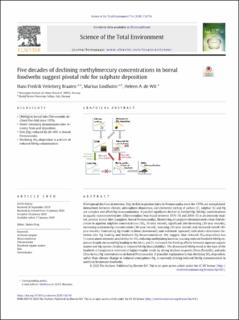| dc.contributor.author | Braaten, Hans Fredrik Veiteberg | |
| dc.contributor.author | Lindholm, Markus | |
| dc.contributor.author | de Wit, Heleen | |
| dc.date.accessioned | 2020-08-26T05:59:46Z | |
| dc.date.available | 2020-08-26T05:59:46Z | |
| dc.date.created | 2020-07-16T08:27:23Z | |
| dc.date.issued | 2020 | |
| dc.identifier.citation | Science of the Total Environment. 2020, 714, 136774. | en_US |
| dc.identifier.issn | 0048-9697 | |
| dc.identifier.uri | https://hdl.handle.net/11250/2673997 | |
| dc.description.abstract | Widespread declines in mercury (Hg) in fish in pristine lakes in Fennoscandia since the 1970s are unexplained. Interactions between climate, atmospheric deposition, and elemental cycling of carbon (C), sulphur (S) and Hg are complex and affect Hg bioaccumulation. A parallel significant decline in methyl-Hg (MeHg) concentrations in aquatic macroinvertebrates (Chironomidae) was found between 1976–78 and 2004–15 in an intensely studied, pristine boreal lake (Langtjern, boreal Fennoscandia). Monitoring at Langtjern demonstrated a four-fold decrease in aqueous sulphate concentrations (SO4, 50-year record), significant lake browning (30-year records), increasing sediment Hg concentrations (50-year record), warming (45-year record) and increased runoff (40-year record). Contrasting Hg trends in biota (downward) and sediment (upward) indicated a disconnect between lake Hg loading and foodweb Hg bioaccumulation. We suggest that reduced SO4-deposition has 1) constrained substrate availability for SO4-reducing methylating bacteria (causing reduced foodweb MeHg exposure despite increased Hg loading to the lake), and 2), increased the binding affinity between aqueous organic matter and Hg species (leading to reduced MeHg bioavailability). The downward MeHg trend at the base of the foodweb at Langtjern is mirrored at higher trophic levels by strong declines in perch (Perca fluviatilis) and pike (Esox lucius) Hg concentrations in boreal Fennoscandia. A plausible explanation is that declining SO4-deposition, rather than climate change or reduced atmospheric Hg, is currently driving reduced MeHg contamination in northern freshwater foodwebs. | en_US |
| dc.language.iso | eng | en_US |
| dc.publisher | Elsevier | en_US |
| dc.rights | Navngivelse 4.0 Internasjonal | * |
| dc.rights.uri | http://creativecommons.org/licenses/by/4.0/deed.no | * |
| dc.title | Five decades of declining methylmercury concentrations in boreal foodwebs suggest pivotal role for sulphate deposition | en_US |
| dc.type | Peer reviewed | en_US |
| dc.type | Journal article | en_US |
| dc.description.version | publishedVersion | en_US |
| dc.source.pagenumber | 10 | en_US |
| dc.source.volume | 714 | en_US |
| dc.source.journal | Science of the Total Environment | en_US |
| dc.identifier.doi | 10.1016/j.scitotenv.2020.136774 | |
| dc.identifier.cristin | 1819529 | |
| dc.relation.project | Norges forskningsråd: 243644 | en_US |
| cristin.ispublished | true | |
| cristin.fulltext | original | |
| cristin.qualitycode | 2 | |

